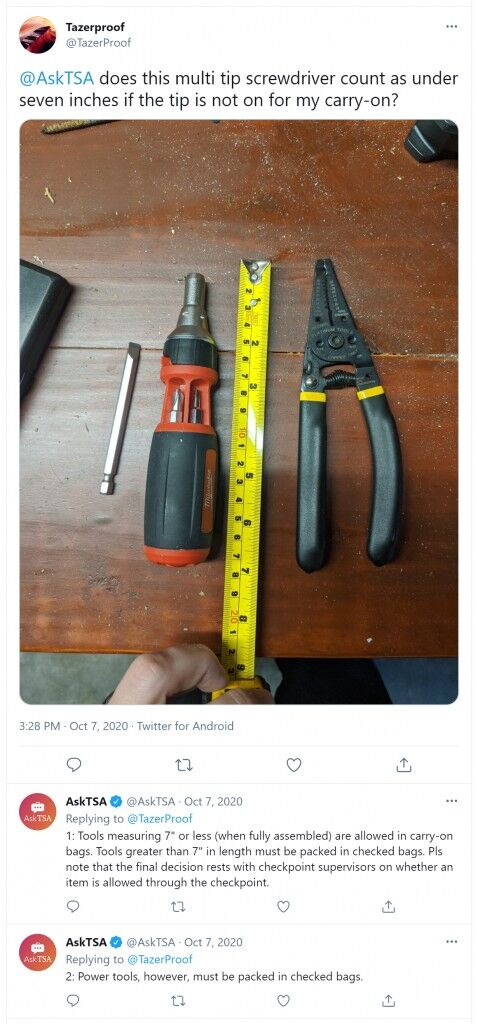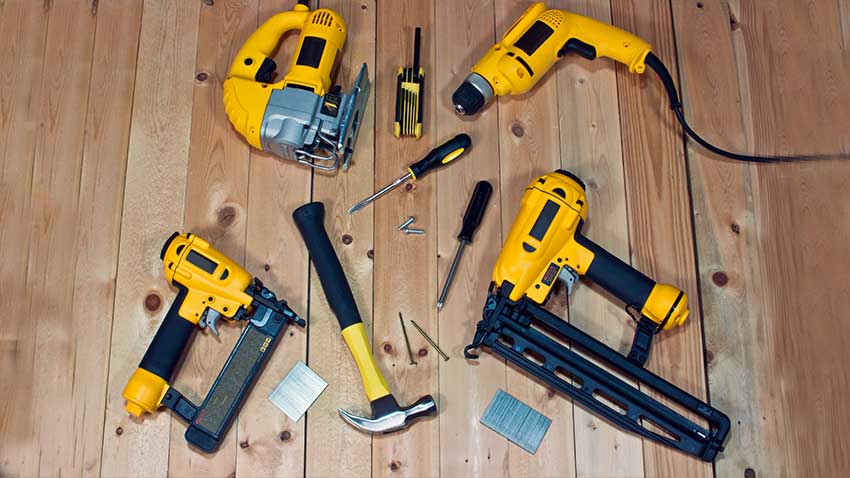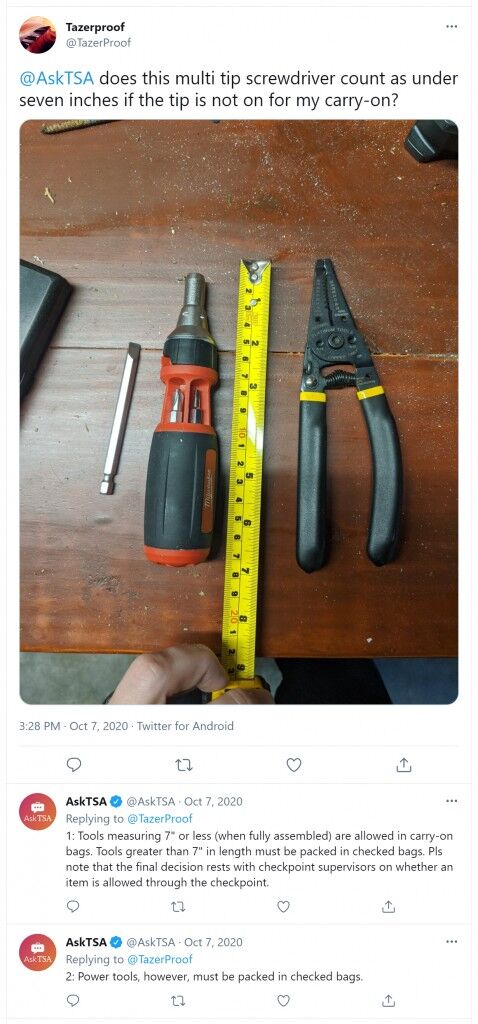Are you wondering if you can take battery power tools on a plane? Well, you’ve come to the right place! Whether you’re a DIY enthusiast or a professional contractor, traveling with your trusty tools can be a concern. But fear not, we’ve got all the answers you need to ensure a hassle-free journey with your power tools.
Now, let’s get down to business. When it comes to traveling with battery-powered tools, there are a few things you need to consider, such as the type of batteries you have and the airline’s rules and regulations. But don’t worry, we’ll break it down for you in simple terms.
So, if you’re ready to learn the ins and outs of bringing battery power tools on a plane, let’s dive right in and get you one step closer to your next project!
Planning to travel with battery power tools? Learn about the rules for taking power tools on a plane.
1. Check the airline’s guidelines to see if battery power tools are allowed in carry-on or checked baggage.
2. Ensure the batteries are properly installed in your tools and are within the acceptable watt-hour limits.
3. Pack your tools securely in a sturdy case to prevent damage during transportation.
4. Declare your power tools at the security checkpoint and follow any additional instructions from the TSA.
Remember to always check with your specific airline before traveling.

Can I Take Battery Power Tools on a Plane?
Traveling by plane can be both exciting and stressful, especially when it comes to knowing what items are allowed in your carry-on or checked luggage. If you’re someone who frequently uses battery power tools for work or hobbies, you may be wondering if you can bring them on a plane. In this article, we will delve into the regulations surrounding battery power tools and provide you with all the information you need to know before your next flight.
Transporting Battery Power Tools: Guidelines and Restrictions
Bringing battery power tools on a plane requires a clear understanding of the rules and regulations set forth by airlines and aviation authorities. Here are the key points to consider:
Lithium-Ion Batteries and Their Restrictions
Most modern battery power tools are powered by lithium-ion batteries, which provide high energy density and longer run times. However, due to the potential fire risk associated with these batteries, there are restrictions on transporting them:
- Lithium-ion batteries must be carried in your carry-on luggage or your personal item. They are not allowed in checked baggage due to the risk of fire.
- Loose lithium-ion batteries are not permitted on aircraft. They must be installed in the device or packed in their original packaging.
- Each passenger is typically allowed to carry spare lithium-ion batteries for personal use, as long as they are under a certain watt-hour (Wh) rating. The specific watt-hour limit can vary by airline, so it’s essential to check with your airline before traveling.
- If your lithium-ion batteries exceed the allowed watt-hour limit, you may need to obtain prior approval from the airline and meet specific packaging requirements.
Non-Spillage and Non-Leakage Requirements
Aside from the limitations posed by lithium-ion batteries, there are general requirements for all batteries, including those used in power tools:
- Battery-powered tools must be safely stored to prevent accidental activation during the flight.
- The battery should be securely installed in the tool or safely enclosed to avoid any risk of contact that could cause a short circuit.
- It’s crucial to ensure that any batteries, whether attached or detached from the tool, do not leak or spill. This includes protecting the power tool from potential damage during transit.
Informing Security Personnel
When passing through airport security, it’s always a good practice to inform the security personnel that you are carrying battery power tools and any spare batteries. This will ensure a smooth screening process and help avoid any confusion or potential issues. Remember to comply with any additional requests or precautions instructed by security personnel.
TSA’s 3-1-1 Rule for Batteries
Be aware that the Transportation Security Administration (TSA) has specific guidelines for carrying batteries on planes, commonly referred to as the 3-1-1 rule:
- Batteries over 100 Wh but less than 160 Wh require airline approval, and you are typically only allowed two spare batteries within this range.
- Batteries over 160 Wh are prohibited from being transported.
- The 3-1-1 rule allows passengers to carry-on batteries with a capacity of up to 100 Wh without airline approval.
International Flights and Destination-Specific Regulations
If you are traveling internationally or to a specific destination, it’s essential to research and familiarize yourself with the transportation regulations of that country or region. Some countries may have stricter regulations or additional requirements for carrying battery power tools on planes. Contact the airline or consult the country’s aviation authority to ensure compliance with any specific guidelines.
Additional Tips for Traveling with Battery Power Tools
Now that you have a clear understanding of the guidelines and restrictions for taking battery power tools on a plane, here are a few additional tips to help ensure a smooth travel experience:
Securely Pack and Protect Your Tools
When packing your battery power tools, it’s important to secure them properly to prevent any damage or accidental activation. Here are some tips:
- Remove any detachable batteries from the tool and pack them separately, following the guidelines mentioned earlier.
- Keep the power tool in a sturdy case or wrap it in protective padding to prevent any impact or pressure during transit.
- Ensure that sharp or protruding parts of the tool are safely covered or secured to avoid injury to yourself or others.
Check Airline’s Specific Policies
While we have covered general guidelines for transporting battery power tools, it’s important to remember that each airline may have its own specific policies or restrictions. To avoid any surprises or issues at the airport, check the airline’s official website or contact their customer service directly. They will provide you with accurate and up-to-date information tailored to their regulations.
Label and Organize Cables and Chargers
It’s a common occurrence to misplace small items like charging cables or adapters during travel. To keep your cables organized and easily accessible, consider the following:
- Label each cable and charger so that you can identify them quickly.
- Use small cable organizers or pouches to keep the cables neatly organized inside your carry-on bag.
- Consider bringing a portable power bank or an external battery charger for your devices, as some airlines may have restrictions on charging electronic devices during the flight.
Summary
Traveling with battery power tools on a plane is possible, but there are important guidelines and restrictions to follow. Lithium-ion batteries must be carried in your carry-on luggage, loose batteries are not allowed, and there are specific watt-hour limits to consider. All batteries should be securely installed in the tool or safely enclosed to prevent leakage or spillage. It’s crucial to inform security personnel about your battery-powered tools and comply with any requests or precautions. Additionally, check the specific policies of the airline you are flying with and be aware of any destination-specific regulations. By adhering to these guidelines and taking proper precautions, you can safely bring your battery power tools with you on your next flight.
Key Takeaways: Can I Take Battery Power Tools on a Plane?
- Battery power tools are generally allowed in carry-on or checked baggage, but there are restrictions and guidelines to follow.
- Batteries must be properly installed in the tools and protected from damage or short-circuiting.
- Spare batteries should be carried in carry-on baggage and not be loose or exposed.
- Lithium-ion batteries have additional rules, such as limits on capacity and quantity.
- It’s important to check with the airline and TSA for specific rules and regulations before traveling with power tools.
Frequently Asked Questions
When it comes to air travel, many people wonder about the rules and regulations surrounding the items they can bring on a plane. If you’re wondering whether you can bring battery power tools in your carry-on or checked luggage, we’ve got you covered. Read on to find the answers to your questions.
1. Are battery power tools allowed on a plane?
Yes, battery power tools are generally allowed on a plane. However, there are some guidelines you should follow to ensure a smooth and hassle-free travel experience. The Federal Aviation Administration (FAA) allows battery-powered tools, including drills, saws, and sanders, in both carry-on and checked luggage. However, there are specific rules regarding the types of batteries that can be brought on board.
For lithium-ion batteries, which are commonly found in power tools, they are generally allowed in carry-on baggage as long as they meet certain watt-hour (Wh) ratings. Batteries with a Wh rating of less than 100Wh are typically allowed without restrictions, while those between 100-160Wh may be subject to additional approval from the airline. It’s always best to check with your airline beforehand to ensure compliance with their specific regulations.
2. Can I bring spare batteries for my power tools?
Yes, you can bring spare batteries for your power tools on a plane. However, there are some restrictions you need to be aware of. The FAA allows you to bring spare batteries as long as they meet the same watt-hour (Wh) rating requirements as the batteries installed in your tools. This means that spare lithium-ion batteries with a Wh rating of less than 100Wh can typically be carried without any special restrictions.
It’s important to note that spare batteries should be packed in your carry-on baggage, rather than checked luggage. This is because lithium-ion batteries have the potential to overheat and cause a fire if they are damaged or short-circuited. By keeping them in your carry-on, you can monitor and respond to any potential issues promptly.
3. Are there any restrictions on the size of battery power tools I can bring?
While there are no specific restrictions on the size of battery power tools you can bring on a plane, it’s essential to consider practicality and safety. Remember that you will need to fit your tools in your carry-on or checked luggage, so consider the size and weight limitations imposed by your airline. Additionally, be mindful of the weight and balance restrictions for checked luggage to avoid any additional charges or potential safety concerns.
If you have large power tools, it may be more feasible to check them rather than carry them on board. However, ensure that they are properly secured and protected to prevent any damage during transit. Always consult the airline’s guidelines and regulations regarding oversized or heavy items before your trip.
4. Do I need to take any precautions when traveling with battery power tools?
Absolutely! When traveling with battery power tools, it’s essential to take some precautions to ensure the safety of yourself and others on the plane. Here are some tips to keep in mind:
– Ensure that the batteries are properly installed and secured in the power tools to prevent accidental activation or damage during transportation.
– Carry the power tools and batteries in a sturdy, padded case to protect them from impact and to prevent any potential damage.
– If possible, remove the batteries from the power tools and tape the contacts or place them in individual plastic bags to prevent short-circuiting.
– Follow any instructions or guidelines provided by the airline or TSA regarding the transportation of battery-powered devices.
By following these precautions, you can have a smooth and stress-free experience when traveling with battery power tools.
5. Are there any specific rules for traveling internationally with battery power tools?
Yes, when traveling internationally with battery power tools, you need to consider not only the regulations of your departing country but also those of your destination country. Different countries may have varying rules and restrictions when it comes to bringing power tools and batteries on board a plane.
It’s crucial to research and familiarize yourself with the specific regulations of both your departure and destination countries. Contact the respective aviation authorities or consult with your airline to ensure compliance with all requirements. By doing so, you can avoid any issues or delays during your international travel with battery power tools.

Summary
So, can you bring battery power tools on a plane? The answer is yes, but with some restrictions. Before you pack your tools, make sure the batteries are less than 100 watt-hours and are securely installed in the tool. Check with your airline for any additional guidelines and be prepared to declare your tools at the security checkpoint. Remember, safety is important, so always carry your tools in your carry-on baggage and never in checked luggage.
In conclusion, you can bring battery power tools on a plane, as long as you follow the rules and regulations. Happy travels, and don’t forget to double-check before you pack your tools!
